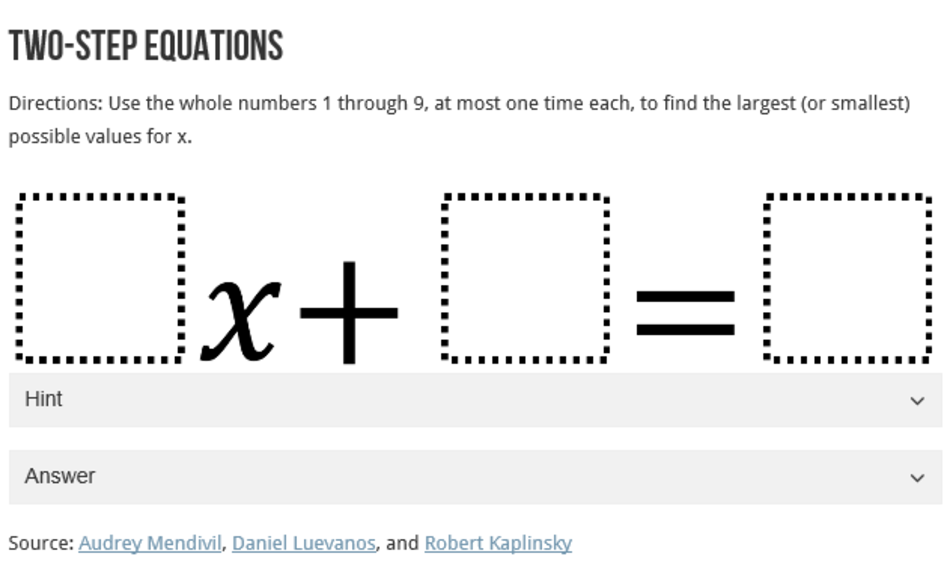|
Rather than telling you about it myself, I've brought in Nanette Johnson, the co-creator of a phenomenal resource called Open Middle. Here is what she has to say: Having kids of my own, I have a 10, 8 and 7 year old, I like when they explain their reasoning, especially in math. One of the challenges that parents may have is helping their child explain their reasoning. I have found some success by asking questions. One of my favorite questions to ask my own kids is, “Can you think of a different way to get the same answer?” This helps them know that math, along with other things, has more than one way to get to the solution. Another reason I love this question is that it helps them validate their answer using a different method. If they get the same answer using 2 seemingly unrelated methods, this gives them confidence in their answer. First, let’s define what an Open Middle problem is. Imagine that a problem has a beginning (the problem or question), a middle (solution path) and an end (the answer or solution). Most problems from a textbook have closed beginning, closed middle and closed end - meaning, they all start, continue and end the same exact way. Instead, Open Middle problems are different in that, they have an open middle, meaning that there are multiple ways to get to the solution. These multiple ways allow students to approach the problem in different ways to validate their answer. Knowing various ways to arrive at the same solution and knowing how these methods are connected strengthens your child’s math skills. So here is an analogy to help better explain this. Imagine that you are at home, but need to go to somewhere (maybe the store or a friend’s house). Are there multiple ways to get there? If you said yes, that’s an example of something having an open middle. You have the same beginning and end, but the middle has different options. Consider these two problems: The traditional problem doesn’t offer much variation, especially in the middle, unless you prompt your student.
The Open Middle problem asks the student to find the LARGEST product. Once they get an answer, ask questions such as:
Another difference between these two problems is the level of complexity in thinking that each is asking of the student. The first problem is likely something their teacher may have shown them how to do. The second is asking something that they most likely have never been asked, but they have the ability to do (given that he/she has learned multiplication). You can help your child become a stronger mathematician not by asking them to do something (or variations of the something) they have seen and done before, but by giving them tasks that are different than what they’ve done before, yet have the ability to complete. So, how can you turn Open Middle Problems into Table Talks? Choose a problem from OpenMiddle.com. The site is organized by grade level, but I strongly suggest a problem that is two or three grade levels below (just to get them used to this kind of thinking). Also, begin with a lower DOK (depth of knowledge, which indicates the level of complexity of thinking required to complete the problem). Do the problem before you give it to them and read any hints or answers that your kid may need. Ask your kids to do the problem (or show them the problem). If your child gets stuck, start asking questions to help guide their thinking to get to the answer. Here are a some of questions that you can use:
Thanks for joining the Table! If you have any questions, please feel free to contact me on Twitter (@TableTalkMath) or comment below. Be sure to have your friends sign up for the newsletter at tabletalkmath.com for weekly updates. Thank you for taking the time to improve math fluency for children, one table talk conversation at a time.
1 Comment
Jenn Carr
5/31/2018 09:17:19 pm
I love the amazing student thinking that comes out during an Open Middle problem. I'll have to try them now with my son and share with colleagues!
Reply
Your comment will be posted after it is approved.
Leave a Reply. |
Details
AuthorJohn Stevens is working to give parents ideas on how to have mathematics-based discussion at home. Archives
May 2018
Categories |



 RSS Feed
RSS Feed